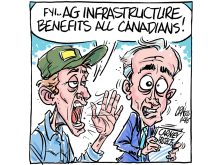Governments occasionally decide to make a grand policy move that irrevocably changes the course of their countries’ economies.
In the late 18th century, Canadian prime minister John A. Macdonald pushed through what he called his National Policy, and at its core was the construction of the Canadian Pacific Railway.
The vision took years to accomplish and came with tremendous costs, not only financial but also political. A corruption scandal brought down Macdonald’s government in the 1870s and almost snuffed out his legacy before it had a chance to solidify.
Read Also

High prices see cow-calf producers rushing to incorporate
Farm accountants are reporting a steady stream of cow-calf producers rushing to get their operations incorporated ahead of selling their calves this fall.
Many would argue, though, that the costs were worth it and that Canada may not even exist today if Macdonald’s vision hadn’t been successful.
Less than a century later, another politician — this time U.S. president Dwight Eisenhower — pushed through the construction of the country’s interstate highway system.
The project cost more than a trillion dollars in today’s money and is thought to have displaced a million people as urban neighbourhoods were obliterated to make way for new freeways.
However, the interstate road network revolutionized transportation in the United States and boosted the economy.
As Canada faces an existential threat from the current U.S. president with his threats of economic warfare and outright annexation, is it time for another grand gesture from today’s politicians?
We would suggest yes, and that the focus this time should be on eliminating interprovincial trade barriers.
It is ludicrous to continue living with east-west trade impediments even as our north-south trade hangs in the balance.
Politicians and industry have been talking about doing something about these barriers for decades, but we would argue that we no longer have the luxury to continue with the approach of all talk and little walk.
Yes, some progress has been made, primarily the Canada Free Trade Agreement of 2017, but this compact still contains too many exceptions.
It’s estimated that interprovincial trade barriers are a tariff equivalent of 21 per cent, and their removal could increase the Canadian economy by $200 billion a year.
What makes these barriers’ removal so difficult is that for the most part, we’re not talking about tariffs on physical goods.
Instead, the barriers come mainly in the form of restrictive regulations that make it daunting to do business between provinces.
This difficulty is exacerbated by the regulations’ focus on health and safety, whether it be a difference of opinion over what makes the safest car seat or the best way to educate a nurse.
A good example are the different rules over the sale of meat across provincial borders.
It may be easy to make the case that Province A should accept the meat inspection standards of Province B, but if Province A insists that all it’s trying to do is look out for the safety of its citizens, how does one argue with that?
One answer would be to adopt national standards across the country for a wide variety of goods and services, but that has its own challenges, considering how jealous the provinces are of their constitutionally provided powers.
So yes, it’s difficult, which explains why in 2025, we’re still talking about this.
Eliminating interprovincial trade barriers may not be as sexy as building a railway or a highway network, but it would have the same effect.
Now is the time to get serious about doing something about it.
Karen Briere, Bruce Dyck, Robin Booker, Paul Yanko and Laura Rance collaborate in the writing of Western Producer editorials.

















